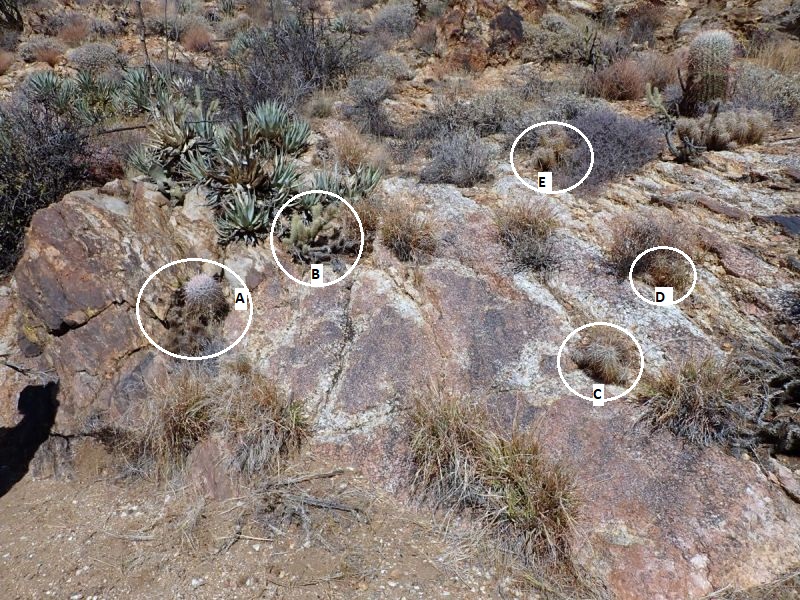Plant Species of the Borrego Desert: Poaceae: Heteropogon contortus, tanglehead
The main purpose of this page was to show photographs of the same spot taken 12.1 years apart to show the changes in the plants during that interval; see Fig. 1. Subsequently, I added another follow-up pix taken on 7.0 years later, to extend the overall interval to 19.1 years.
Larry Hendrickson took the first photograph when he discovered Heteropogon contortus growing in Cool Canyon on 31 December 2005. Tom Chester took the second photograph on 10 February 2018, and the third photograph on 21 February 2025.
Even though the Jepson Manual Second Edition lists this species as naturalized in California (the First Edition called it native), and even calls it a noxious weed, it is clearly native to the southwest since it has been found in packrat middens dating to 7900 years ago (Felger 2000, Flora of Gran Desierto ...). Jon Rebman argues persuasively that it is also native to at least the desert portion of San Diego County since it is definitely native in Baja California, and has a similar distribution in its entire range in the Southwest U.S. and Mexico as other plants with few occurrences in San Diego County that are considered native here. This argument was bolstered by Fred Melgert and Carla Hoegen discovering another population of this species recently just southeast of Dave McCain Spring, east of Whale Peak, in a very remote area visited by few people.
This species is called a noxious weed just because the seeds of this species get tangled in the wool of sheep.

|

|

|
| Fig. 1. Top: Photograph from 2005 by Larry Hendrickson. Middle: Photograph from 2018 by Tom Chester. Bottom: Photograph from 2025 by Tom Chester. Click on the pictures for larger versions. |
Links to the original photographs without labels: 2005 photograph by Larry Hendrickson; 2018 photograph by Tom Chester.
The easiest way to compare these pictures is probably to save them to your computer, then open both of them in the same application and either display them side by side, or put them on top of each other and then switch between them by using alt-tab on a windows computer or command-' on a Macintosh computer.
Comparison of the 2005 and 2018 pix
Comments on Heteropogon plants.
The Heteropogon plants are numbered in each image. Plants 1 through 11 were seen in the 2005 image, and the corresponding locations have the same numbers in the 2018 image. Of those, they are either much diminished or missing in the 2018 image. Plants 6 and 10 appear to be missing in the 2018 image.
Plants 12 through 14 are new plants seen only in the 2018 image, and they appear healthier than the other plants in the 2018 image. This may indicate that the lifetime of the Heteropogon plants is on the order of 20 years.
Comments on other species.
The Agave plants in the upper left appear to be very similar in the two images.
Circles denote some of the other species, labeled with letters.
The Ferocactus in circle A has gotten a bit larger, but the Echinocereus with it appears mostly unchanged.
The Cylindropuntia ganderi in circle B has had major changes. The stem that is decumbent to the right in the 2005 image has died, and is black and shriveled in the 2018 image. The other stems are pretty much unchanged, albeit with a bit of growth. Overall, the plant has decreased in live biomass.
The Echinocereus in circle C has become significantly bigger, with ~9 stems now compared to ~5 stems in 2005.
The Echinocereus in circle D was not present in 2005, and has grown two stems in that time interval.
The Echinocereus in circle E has become significantly bigger, with ~8 stems now compared to ~4 stems in 2005.
It is a bit difficult to comment on the Encelia farinosa plants here since it was very dry on 10 February 2018, and most plants of that species looked dead, even though most were just dormant. But clearly the lowermost plant in 2005 is no longer present.
Comparison of the 2018 and 2025 pix
The Heteropogon plants are much happier in 2025, continuing their trend of greater happiness in 2018.
Two Agave rosettes flowered and then died in 2025. Agave rosettes always die after flowering. The smaller rosettes in 2018 have gotten larger.
The two Ferocactus cylindraceus plants have gotten taller. The one in circle A was measured to be 13 inches tall and 7 inches wide in 2025. The size in the other photographs is not directly comparable since the photos were taken from slightly different locations. Using the size of the nearby rock features to get a relative scale in each pix, gives a height of 9.6 inches in 2005, and 11.3 inches in 2018. This is a growth rate of just 0.18 inches per year (0.46 cm / year). This is by far the slowest growth rate I've yet calculated, with the other growth rates varying from 0.8 to 2.0 cm / year.
The slow growth rate is probably due to the challenging growing conditions this barrel is in, growing in a south face boulder, with limited water and soil supply.
The taller barrel at upper right has clearly grown much faster. Unfortunately, its base is not visible in the 2018 photo, so I can't directly calculate its growth rate.
The Echinocereus in circle A is now dead. The Echinocereus in circles C and E are much smaller in 2025 than they were in 2018.
I thank Larry Hendrickson for finding and vouchering these plants, for sending me the photograph reproduced on this page, and for permission to put the photograph online.